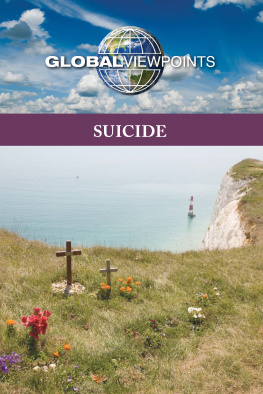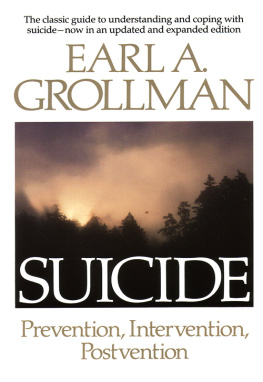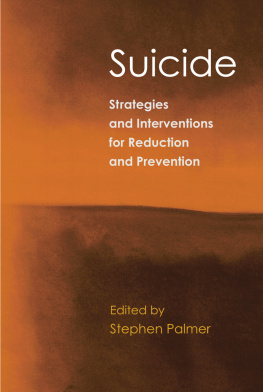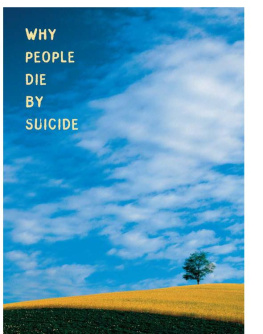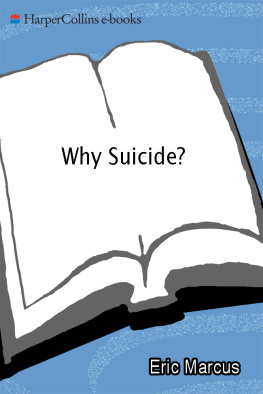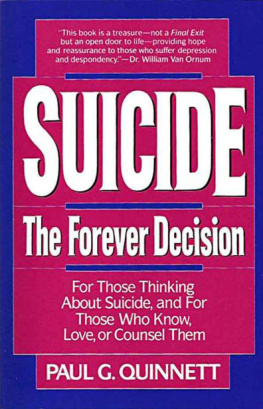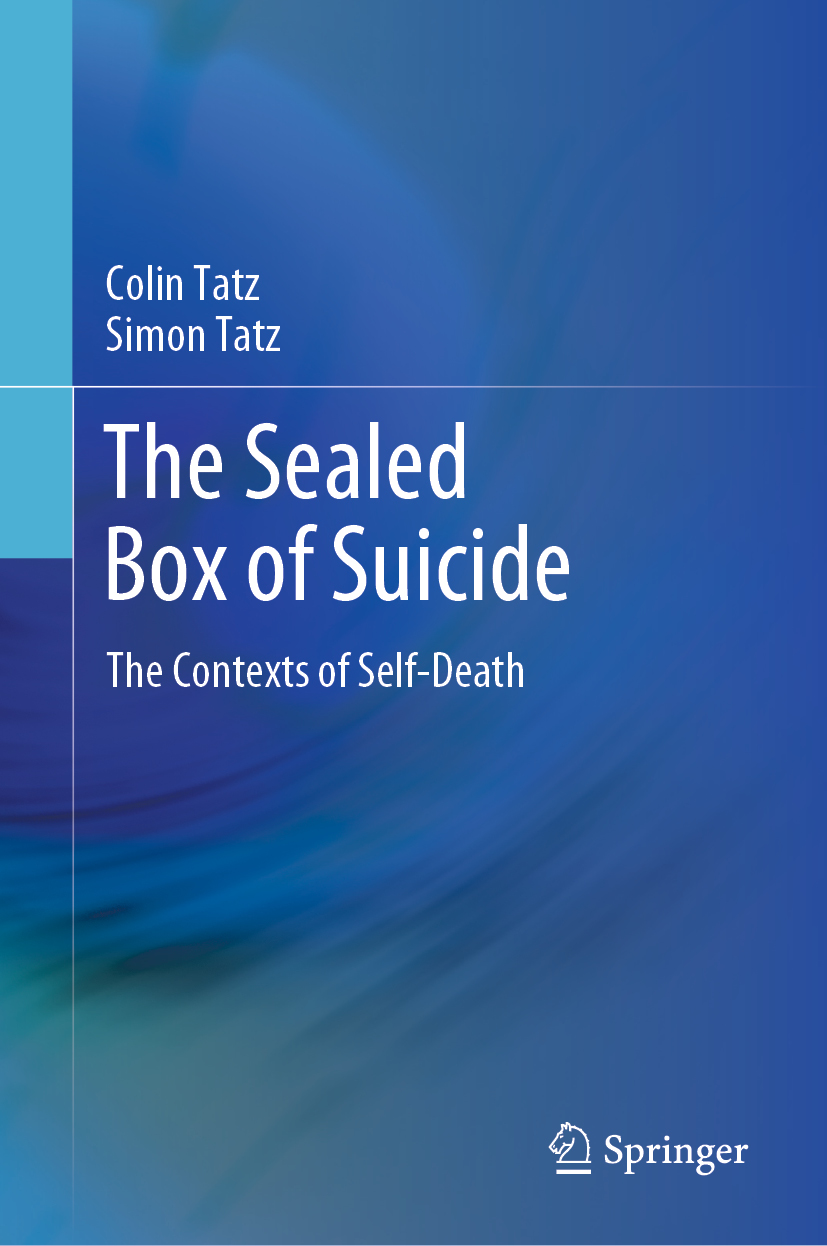Colin Tatz and Simon Tatz
The Sealed Box of Suicide
The Contexts of Self-Death
Colin Tatz
Australian National University, Canberra, ACT, Australia
Simon Tatz
Curtin, ACT, Australia
ISBN 978-3-030-28158-8 e-ISBN 978-3-030-28159-5
https://doi.org/10.1007/978-3-030-28159-5
Springer Nature Switzerland AG 2019
This work is subject to copyright. All rights are reserved by the Publisher, whether the whole or part of the material is concerned, specifically the rights of translation, reprinting, reuse of illustrations, recitation, broadcasting, reproduction on microfilms or in any other physical way, and transmission or information storage and retrieval, electronic adaptation, computer software, or by similar or dissimilar methodology now known or hereafter developed.
The use of general descriptive names, registered names, trademarks, service marks, etc. in this publication does not imply, even in the absence of a specific statement, that such names are exempt from the relevant protective laws and regulations and therefore free for general use.
The publisher, the authors and the editors are safe to assume that the advice and information in this book are believed to be true and accurate at the date of publication. Neither the publisher nor the authors or the editors give a warranty, expressed or implied, with respect to the material contained herein or for any errors or omissions that may have been made. The publisher remains neutral with regard to jurisdictional claims in published maps and institutional affiliations.
This Springer imprint is published by the registered company Springer Nature Switzerland AG
The registered company address is: Gewerbestrasse 11, 6330 Cham, Switzerland
In memory
of
great-uncle (and great-great uncle) Dotke,
who talked and looked like a poet
but sold chicken-feed instead;
a bad book-keeper,
he took his life
because he misread his healthy credit column
as a debit.
Acknowledgements
Writing a book about suicide, and having something new to say, is a tough business. The men and women we thank have helped with grace and kindness. A few have commented on ideas, assumptions and judgments. Several provided sources.
Our warmest thanks to Hannah Andrevski, Vicken Babkenian, Michael Barnes, Douglas Booth, Amanda Bresnan, Belinda Carpenter, Alain Coltier, Panayiotis Diamadis, Michael Diamond, Armen Gakavian, Meher Grigorian, Gillian Heller, Herbert Herzog, Ian Hickie, Winton Higgins, Wendy Johnson, Michael Kral, Margaret Macallister, Ian Marsh, John Mendoza, Jessica Palmer, Nicole Roberts, Michael Robertson, David Robinson, Alan Rosen, Kim Ryan, Jennifer Schultz Moore, Said Shahtahmasebi, Linda Shields, Gordon Tait, Akiva Tatz, Corey Tatz, Karen Tatz, Paul Tatz, Tracey Westerman, Asher Westropp-Evans, Jennifer White and Lesley Yee.
Sebastian Rosenberg reviewed the entire manuscript, made critical and useful comments, added sources and helped shape the final text. We heeded his wisdom. Ross Mellick gave us several throwaway lines that became long paragraphs. Michael Dudley provided significant sources and suggestions. Pam Tatz sorted out the citations and footnotes. Sandra Tatz gave her sage advice, time and editing skills to this project. Shinjini Chatterjee, Jayanthi Krishnamoorthi and Muruga Prashanth Rajendran handled the books production with great style.
A special thanks to Belinda Carpenter and Gordon Tait who brought Colin Tatz into the team that was awarded an Australian Research Grant award, DP 150101402, Investigating the coronial determination of suicide as a category of death, 20152019.
Contents
About the Authors
Colin Tatz
was Professor of Politics at the University of New England and Macquarie University in Australia. He is now an honorary lecturer in Politics and International Relations at the Australian National University. His books treat comparative race politics, Aboriginal affairs, genocide studies, migration, suicide and sports history.
Simon Tatz
has been Director of Communications (Mental Health Australia), Director of Public Health (Australian Medical Association), Manager of Media and Marketing (ACT Health), Director of Policy (Mental Health Victoria), Chief of Staff (Minister for Higher Education) and a policy and media adviser in the Australian Parliament.
Springer Nature Switzerland AG 2019
C. Tatz, S. Tatz The Sealed Box of Suicide https://doi.org/10.1007/978-3-030-28159-5_1
1. Explanations
Colin Tatz
(1)
Australian National University, Canberra, ACT, Australia
(2)
Curtin, ACT, Australia
Colin Tatz (Corresponding author)
Email:
Suicides often, by the very nature of their death in our society, put their skeletons in their survivors closets.
Edwin Shneidman [American clinical psychologist and suicidologist, 19182009]
Suicide is a form of murderpremeditated murder. It isnt something you do the first time you think of doing it. It takes getting used to. And you need the means, the opportunity, the motive. A successful suicide demands good organisation and a cool head, both of which are usually incompatible with the suicidal state of mind.
Susanne Kaysen [American novelist]
Abstract
The purpose of the book is to examine why society reacts so strongly and so badly to suicide; to evoke fresh thinking about a taboo by bringing to light the external and contextual factors that impinge on self-death; to canvass the conventional biomedical model of suicide as illness.
Keywords
Provocation Spurs to this book Social change
Readers need to know what this book is and what it isnt.
It is not a textbook but it could be instructive for the professionals who deal with suicide and for the families who have lost a member. We hope that it speaks to a public that is curious or simply interested in finding out more about this bewildering behaviour. The book is not a polemic in the diatribe sense, nor an attack on the medical profession and the suicide prevention agencies. Some may read it that way and some will do so, but to question, even sharply, is not to attack. It is not a treatise on suicide theory, nor a research essay based on systematic investigation (apart from the chapter on Australian coroners and aspects of Australian Aboriginal genocide). It is not the outcome of a set of clipboard questionnaire responses. It is not based on official suicide statistics and their analyses, much of which is dubious rather than contentious. In no way is it a belittling of religious beliefs.
The essence of suicide, if it is to be found, requires looking at individual cases and circumstances, not in official figures. But this is a critical work that examines the merits and faults of professions that purport to comprehend the nature of suicide and insist they can prevent the phenomenon.



